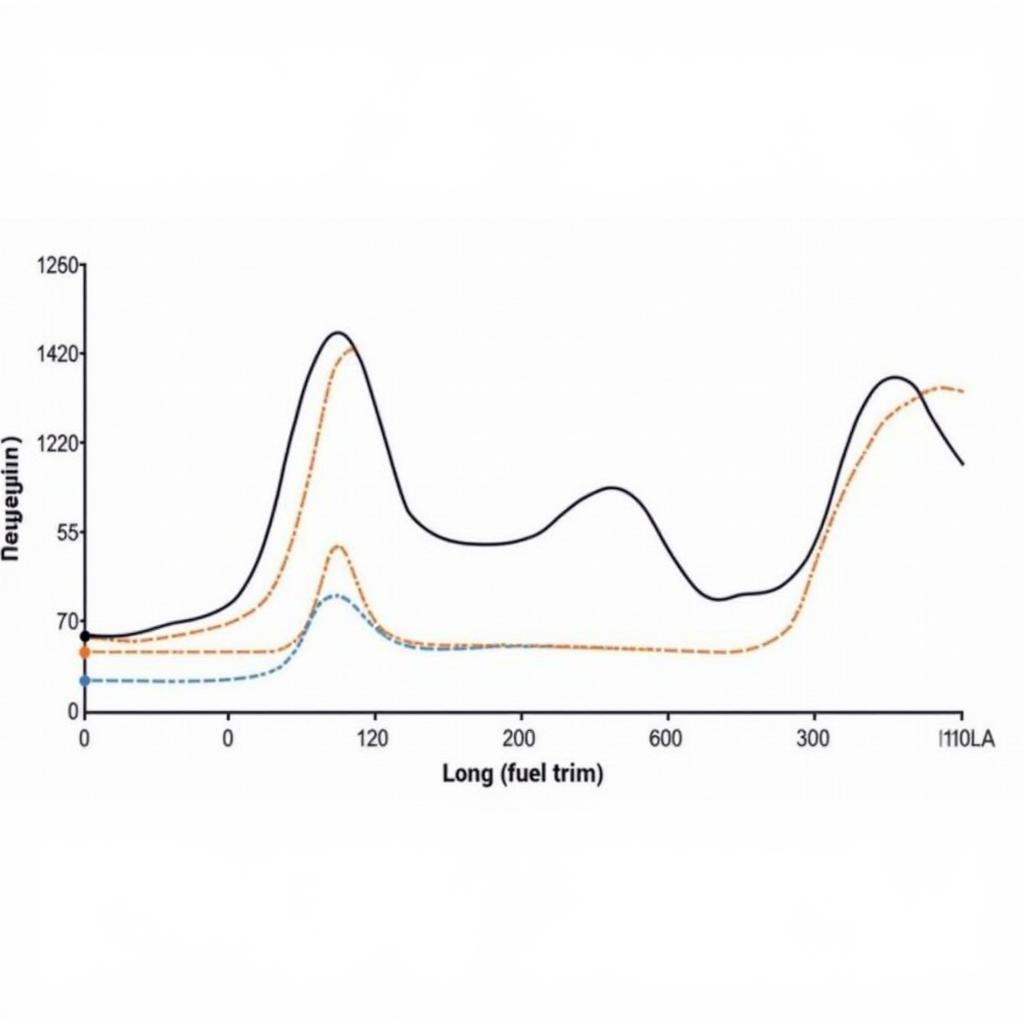Long fuel trim is a crucial diagnostic parameter accessible through your car’s OBD2 port. It provides valuable insights into your engine’s fuel management system, helping you identify potential issues and optimize fuel efficiency. This article delves deep into the world of OBD2 long fuel trim, explaining what it is, how it works, and how to interpret its readings.
What is OBD2 Long Fuel Trim?
Your car’s engine constantly adjusts its fuel-to-air ratio to ensure optimal combustion. This ratio impacts engine performance, fuel economy, and emissions. The OBD2 system monitors this adjustment process through two parameters: short-term fuel trim and long-term fuel trim.
Long fuel trim (LFT) represents the long-term adjustments made by the engine control unit (ECU) to maintain the ideal fuel-to-air mixture. It reflects the ECU’s learned corrections based on continuous feedback from the oxygen sensors.
How Does Long Fuel Trim Work?
The process starts with the oxygen sensors, located in the exhaust system. These sensors measure the oxygen content in the exhaust gases, providing feedback to the ECU about the fuel-to-air ratio. If the oxygen sensors detect a rich mixture (too much fuel), the ECU will decrease the amount of fuel injected. Conversely, a lean mixture (too little fuel) prompts the ECU to increase fuel injection.
Short-term fuel trim handles immediate adjustments, while long-term fuel trim kicks in for persistent deviations from the ideal ratio. The ECU stores these long-term adjustments in its memory, using them to fine-tune fuel delivery over time.
Interpreting OBD2 Long Fuel Trim Readings
You can access long fuel trim readings using an OBD2 scanner. The readings are typically displayed as a percentage, representing the deviation from the ideal fuel-to-air ratio. Here’s a general interpretation:
- Positive LFT values (+%): Indicate a lean fuel mixture, meaning the ECU is adding fuel to compensate.
- Negative LFT values (-%): Indicate a rich fuel mixture, meaning the ECU is reducing fuel to correct the imbalance.
For optimal performance, aim for long fuel trim values within the +/- 10% range. Values exceeding this range may signal an underlying issue requiring attention.
Common Causes of High Long Fuel Trim Readings
High long fuel trim readings, either positive or negative, can stem from various factors, including:
- Vacuum Leaks: Air leaks in the intake manifold or vacuum hoses can disrupt the fuel-to-air ratio, leading to lean conditions and positive LFT values.
- Faulty Oxygen Sensors: Inaccurate readings from oxygen sensors can mislead the ECU, causing inappropriate fuel adjustments.
- Dirty or Clogged Fuel Injectors: Restricted fuel flow from clogged injectors can result in lean mixtures and positive LFT values.
- Failing Fuel Pump: A weak fuel pump may struggle to deliver sufficient fuel, leading to lean conditions and increased LFT.
- Exhaust Leaks: Leaks in the exhaust system, particularly before the oxygen sensors, can disrupt sensor readings and affect fuel trim.
Troubleshooting High Long Fuel Trim
Diagnosing the root cause of high long fuel trim requires a systematic approach. Here’s a step-by-step guide:
- Check for Error Codes: Scan your vehicle’s OBD2 system for any stored diagnostic trouble codes (DTCs). These codes can provide valuable clues about the specific area of concern.
- Inspect for Vacuum Leaks: Carefully examine the intake manifold, vacuum hoses, and related components for any signs of leaks or cracks.
- Test Oxygen Sensors: Use a multimeter or an advanced scan tool to test the functionality of your oxygen sensors, comparing their readings to manufacturer specifications.
- Clean or Replace Fuel Injectors: Consider cleaning or replacing your fuel injectors if they are clogged or malfunctioning.
- Inspect Fuel Pressure: Use a fuel pressure gauge to check if the fuel pump delivers adequate pressure, as specified by the vehicle manufacturer.
- Examine the Exhaust System: Thoroughly inspect the exhaust manifold, pipes, and muffler for any leaks, particularly before the oxygen sensors.
Frequently Asked Questions (FAQ)
Q: What is the difference between short-term and long-term fuel trim?
A: Short-term fuel trim handles immediate, temporary adjustments to the fuel-to-air ratio, while long-term fuel trim reflects more permanent corrections based on continuous feedback.
Q: Can I drive my car with high long fuel trim?
A: While driving short distances with slightly elevated LFT values might be possible, it’s crucial to address the underlying issue promptly. Ignoring high LFT readings can lead to decreased fuel economy, reduced engine performance, and potential damage to catalytic converters.
Q: How often should I check my long fuel trim?
A: It’s good practice to monitor your long fuel trim periodically, especially if you notice any changes in your vehicle’s fuel efficiency or performance.
Conclusion
Understanding your car’s OBD2 long fuel trim is crucial for maintaining optimal engine performance and fuel economy. By regularly monitoring this parameter and addressing any significant deviations, you can ensure your engine runs smoothly and efficiently for years to come.
Remember, if you encounter persistently high or fluctuating long fuel trim readings, it’s always best to consult a qualified mechanic for a comprehensive diagnosis and repair.
Need further assistance with OBD2 diagnostics or have questions about long fuel trim? Don’t hesitate to reach out to our expert team via WhatsApp: +1(641)206-8880 or email us at [email protected]. We’re available 24/7 to provide dedicated support.


